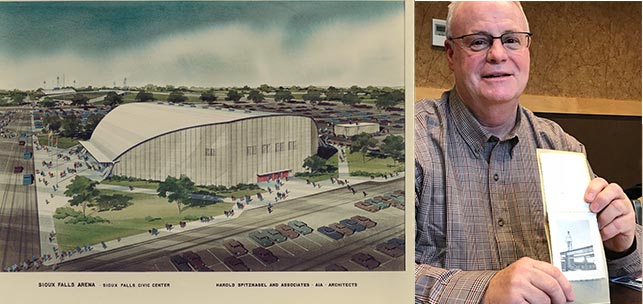Members of #TeamTSP who work in Sioux Falls see one of the firm’s legacy designs daily since the office is located across West Avenue from the Sioux Falls Arena. The building has been a landmark in Sioux Falls since 1961, and its future now is the subject of discussion.
http://siouxfalls.business/in-sioux-falls-arena-legacy-of-progress-coming-full-circle/
Though now yellowed and faded, the newspaper clipping still conveys the excitement people felt as Sioux Falls’ new sports and entertainment venue took shape. The photograph’s cutline describes the new structure’s size: “Huge Arches Placed for Arena,” it reads. “A 120-foot crane lowers into place a half-section of one of the eight 32,000-pound steel arches used in construction of the Sioux Falls Arena.”
With the Sioux Falls Arena nearing its 60th year, questions have arisen on its future. The Denny Sanford Premier Center now hosts the entertainment acts that come to Sioux Falls. The Arena, meanwhile, draws basketball fans, circus-goers, and those in town for trade shows. City officials are expected to decide in the coming year whether the Arena should be restored, renovated or rebuilt.
The venue, designed by architects and engineers from the firm now known as TSP Inc., signaled a change in attitudes in Sioux Falls, a physical and mental transition toward being viewed as a city, not a town. The building’s construction meant the city was looking ahead to a future of continued growth and expanded regional impact.
The public watched the construction of the Sioux Falls Arena with interest, relying on the newspaper for updates or driving by. However, in building superintendent Lawrence Sorenson’s home, updates were daily and much more personal for what his son Russ Sorenson now calls “a unique landmark on the prairie.”
Black-and-white photos show Lawrence’s wife, Stella, with their three older children, dressed in their Sunday best, standing in front of equipment and the steadily rising building—no hard hats, no protective gear.
“I remember that just like it was yesterday,” said Russ, today an urban planner with the city of Sioux Falls deeply involved with the city’s growth. “We’d visited other, smaller projects, but this was the big one.”
Lawrence Sorenson — “Sorny” to his friends and co-workers — had returned from World War II sickened by the horrific destruction done not only to buildings but to people’s lives. He was determined to devote the rest of his life to building, his son said. Financial issues prevented him from completing his architectural training, but a longtime position with Henry Carlson Co. helped Sorny achieve his goal.
Russ Sorenson looks around Sioux Falls and sees evidence of his father’s lifetime of labor. Sorny worked on schools, hospitals, the Minnehaha County Administration Building, churches and the Sioux Falls Arena. He had just finished St. Mary Catholic Church’s construction when Henry Carlson Co. moved him to the Arena project.
Led by architect Harold Spitznagel, TSP received the commission for the proposed Sioux Falls Arena and Convention Center, which was to include a fine arts theater, in 1958. The concept began as a circular building with a master plan that proposed a $2.5 million Arena. Voters balked at the cost and narrowly defeated the initial bond issue. The project’s size and budget were scaled back to reflect a $1.5 million plan. Spitznagel’s firm designed a building with an arched roof and octagonal arena. Final specs and bidder drawings were completed in August 1959, and the Arena was dedicated Dec. 10, 1961. The program for the event noted that it could seat almost 9,500 people for basketball games and 11,000 for public meetings.
When Henry Carlson Co. named Sorny as building superintendent, it chose a man who prided himself on his crew’s safety record and getting a job done within budget and on time, Russ Sorenson said. His father also relished a challenge. Sorny would review blueprints Sunday evenings. He would lay awake at night hoping he’d laid out the building correctly and that the steel arches would fit together properly.
“The Arena was a unique building because it had a different roof line,” Russ Sorenson said. “It was out in the middle of nowhere, and it was something exciting, something new for a community in terms of its architectural opportunities for entertainment. It was a structure on the prairie that was really iconic for Sioux Falls at the time.”
Years later, when rock beneath the Arena had to be blasted away to serve a new ice rink, Sorny was called in to review his notes on how much dynamite had been used during the original construction.
TSP principal and architect Sean Ervin has attended numerous events at the Sioux Falls Arena since he moved here in 2006.
“I love the interior feel of that building. It feels its age, but there’s a cool enveloping sensation when you’re sitting up in the seats,” Ervin said. “In newer event centers, they put the ceiling so high you don’t have the same kind of feeling.”
Russ Sorenson doesn’t presume to predict precisely what his father, so determined to ease the pain of a world war by building something new, would think of a Sioux Falls without an Arena.
“He was part of a generation that tore things down through the war; he wanted to come back and build something and preserve it,” Russ Sorenson said. “But he knew, too, that everything has a lifespan. But do due diligence. It he was here, he’d say study it. Do a good study on it.”

